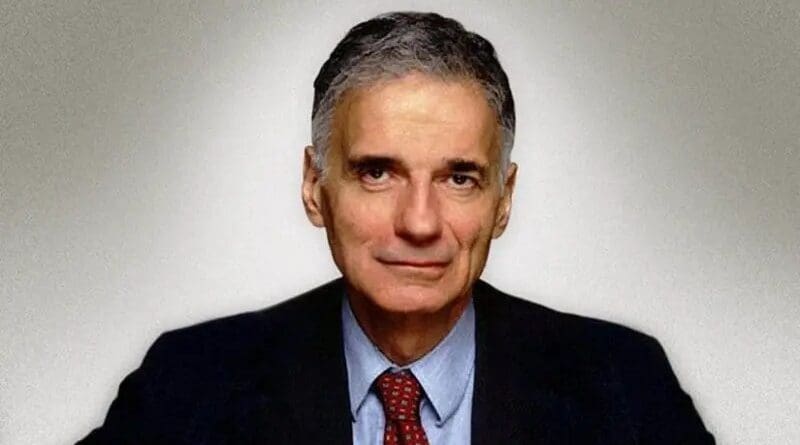Ralph Nader: Ken Bossong, ‘Favorite Sun’ – OpEd
By Ralph Nader
If Mother Sun were to select a favorite son on Planet Earth, Ken Bossong would be high on the list. Operating for over forty years on a tiny budget from a tiny office in Takoma Park, Maryland, the unsung solar energy advocate has been a one-man informing and organizing machine.
He founded the Sun Day campaign in 1992, in his words, “to aggressively promote sustainable energy technologies as cost-effective alternatives to nuclear power and fossil fuels.”
With renewables like solar and wind energy becoming the fastest growing sources of new energy in many areas of the world, Bossong is now seeing his long and often frustrating battles against the traditional corporate skeptics increasingly vindicated. The doubters, often fueled by vested interests in oil, gas, coal and atomic power, called solar unreliable, too diffuse, said that energy from solar couldn’t be stored and that it was too expensive to produce.
I recall in the seventies nuclear engineers at the Hanford Reservation in Washington state derisively that solar power just “sophisticated plumbing”–unworthy of the attention of skilled technical talent.
Notwithstanding their rhetorical dismissals, the fossil fuel and nuke companies saw solar as bad for more parochial reasons. Solar could put them out of business or at least cut into their sales. Solar could be produced in a decentralized manner that would disrupt monopolies; solar was a suitable vehicle for small business and homeowners to garner control away from the centralized power of the Big Energy Giants. Solar also has the advantage of being safer, more abundant everywhere, and environmentally benign.
The visual contrast could not be clearer. On the one hand there are the oil spills and air pollution, the pipeline problems of natural gas with its deadly methane and greenhouse gas releases, the vast destruction of coal—strip mines and subsidence, blown away mountains, dirty air, and millions of coal worker casualties from lung disease and coal mine collapses over the past 130 years. On the other hand, solar panels, solar thermal, solar photovoltaics and wind power draw a stark contrast. If wind power locations cause some controversies, they pale in comparison with the unsafe, uneconomic, uninsurable, unevacuable, stalled nuclear technology that now has to rely on a 100% government taxpayer guarantee for any expansion.
Steadfast and serious, Ken Bossong calmly steeps himself in the startling statistics put out by the Federal Energy Regulatory Commission (FERC) and the U.S. Energy Information Administration (EIA), which are showing that “nuclear power is rapidly losing the race with renewable energy sources.”
Consider three data sets from six months in 2016 by these two agencies. In energy production, “renewable resources (i.e. biofuels, biomass, geothermal, hydropower, solar and wind) accounted for 5.242 quadrillion Btus (quads) of domestic energy production. By comparison, nuclear power provided 4.188 quads. That is, renewables outpace nuclear by more than 25%.”
In total, available installed generating capacity in the U.S., from the combination of utility-scale renewables, has grown to 215.82 gigawatts or 18.39% of total generating capacity while nuclear power’s installed capacity is only 107.06 gigawatts or 9.12% of the total.
“However,” reports Bossong, “actual electrical generation by nuclear plants for the first seven months of 2016 is 19.9% of total generation.” This has been steady for many years and is “still higher than that provided by renewable sources which contributed 15.8% (a figure which does not include electricity produced by distributed renewables such as rooftop solar).”
These figures are rarely reported in the mainstream media. Instead the newspapers and radio/television companies are taking millions of dollars in advertisements from the Nuclear Energy Institute—a lobbying arm of the atomic power industry—declaring that the safe, clean power of the atom is the wave of the future. There is no mention of ageing plants, earthquake risks, the recent shutdown of several nukes, nor the cessation of new construction due to extreme costs. The latest disaster at Fukushima in Japan dissolved the nuke industry’s mantra that risks of meltdowns are “vanishingly small.”
The political power of the fossil fuel and nuclear lobbies is much greater than the renewables. Over the decades they have forged tight relationships with federal and state lawmakers and executive agencies. Many of their officials are well placed in government positions. And fossil fuel fat cats like the Koch brothers are busy pumping money into election campaigns.
Yet, look around you. Installers are placing solar panels on homes and other buildings all over the country. Wind turbines are being erected on hillsides everywhere. Geothermal energy’s nascent promises are finally coming to fruition. Major companies like Google are moving toward renewables and are even investing in their generation.
A long distance runner, Ken Bossong, continues to press his Sun Day campaign. Sign up for Sun Day campaign alerts by sending an email to: [email protected]. Twitter: follow @SunDayCampaign. Ken Bossong is another example of one person making a serious difference.

